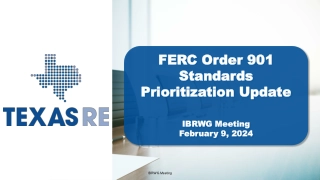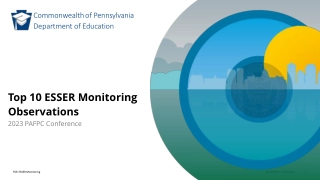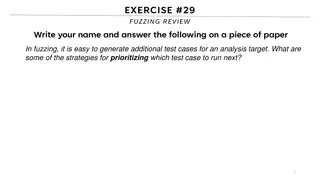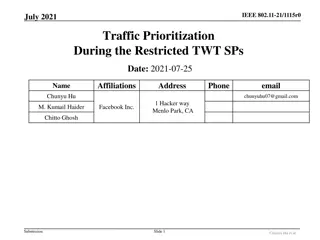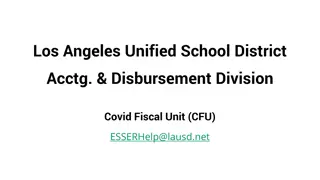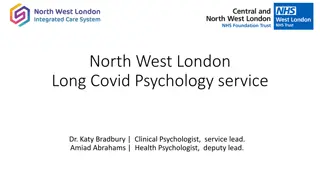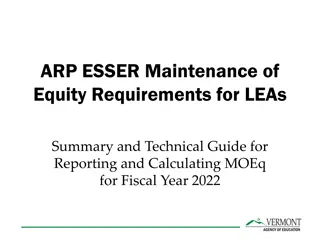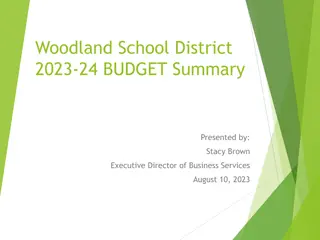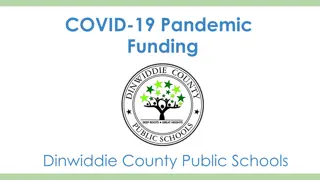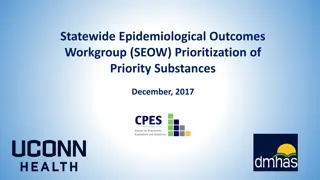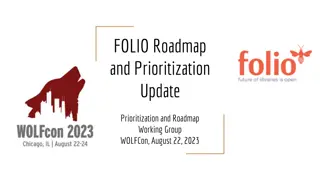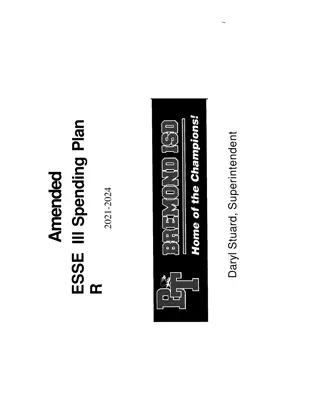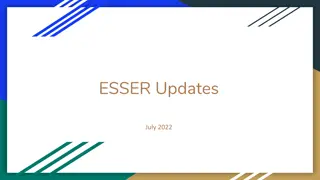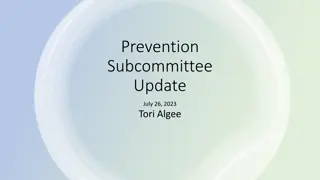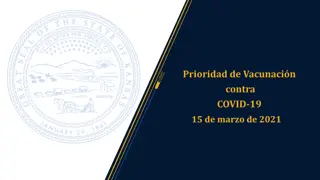COVID Update and ESSER Prioritization Summary by Andrew Strope - February 25, 2021
The update by Andrew Strope, Chief Strategy and Planning Officer, on COVID-related initiatives provides insights on the impact on schools, positive test cases, quarantines, vaccinations, and general updates. Details include positive cases, quarantines, grade-wise statistics, vaccination eligibility, CDC guidance on quarantine, and distribution of KN95 masks to schools by ISDH.
Download Presentation

Please find below an Image/Link to download the presentation.
The content on the website is provided AS IS for your information and personal use only. It may not be sold, licensed, or shared on other websites without obtaining consent from the author. Download presentation by click this link. If you encounter any issues during the download, it is possible that the publisher has removed the file from their server.
E N D
Presentation Transcript
COVID Update and ESSER Prioritization Andrew Strope, Chief Strategy and Planning Officer February 25, 2021
Objectives/Agenda 2 Provide an update on COVID-related initiatives and data points Provide an overview of the Emergency Elementary and Secondary School Emergency Relief Fund (ESSER) and the framework for how IPS will determine the use of funds
COVID Update COVID Impact on Schools 4 Since returning to school in mid January, we have had 169 positive cases and 636 students or staff in quarantine. We ve had 18 instances where one or more classrooms had to be moved to remote learning.
COVID Update Positive Tests (1/03/2021 - 2/13/2021) 5 Grade Configuration Staff Student Total 14 0 Central Services 14 52 Elementary 51 103 21 12 Middle School 33 10 High School 9 19 96 73 Total 169
COVID Update Quarantines (1/03/2021 - 2/13/2021) 6 Grade Configuration Staff Student Total 20 0 Central Services 20 98 Elementary 455 553 26 18 Middle School 44 7 High School 12 19 150 486 Total 636
COVID Update Vaccinations 7 Marion County is currently in Phase 1B of vaccine eligibility, which includes eligibility for all Hoosiers age 65 and older SPED staff who provide specific assistance to SPED students are eligible for the vaccine. Visit www.myips.org for access to information about vaccinations in Marion County and how to register
COVID Update General Updates 8 New CDC quarantine guidance - Quarantine is no longer required following a close contact if vaccinated AND all of the following criteria are met: Are fully vaccinated (2 weeks after getting second dose) Are within THREE months after getting the last does NO COVID-19 symptoms Mask reminders shared to all staff: Masks should fit snugly against the face and have a nose wire Double masking is encouraged (cloth w/disposable or multilayer cloth) A KN95 mask should NOT be worn with additional masks As a part of statewide distribution, ISDH will be providing IPS with KN95 masks for all schools; will be dispersed once received.
COVID Update Historical YTD Attendance (as compared to same time 9 period)
COVID Update YTD Average Attendance by Learning Community 10
Elementary and Secondary School Emergency Relief Fund (ESSER) 11
ESSER II What is ESSER 12 In December of 2020, Congress set aside approximately $13.2 billion for the Elementary and Secondary School Emergency Relief Fund (ESSER Fund). The Department of Education will award these grants to State educational agencies (SEAs) for the purpose of providing local educational agencies (LEAs), including charter schools that are LEAs, with emergency relief funds to address the impact that COVID-19 has had, and continues to have, on elementary and secondary schools across the nation.
ESSER II Guidelines and Impact to IPS 13 Topic ESSER 1 (CARES Act) ESSER II (CRRSA) Period of Funds Availability May be used for pre-award costs dating back to March 13, 2020, when the national emergency was declared Same as ESSER Fund (CARES Act): May be used for pre-award costs dating back to March 13, 2020, when the national emergency was declared Available for obligation by State educational agencies (SEAs) and subrecipients through September 30, 2022* Available for obligation through September 30, 2023* Allowable Use of Funds The CARES Act includes allowable uses of funds related to preventing, preparing for, and responding to COVID-19 Focus on addressing learning loss, preparing schools for reopening, and testing, repairing, and upgrading projects to improve air quality in school buildings Impact on IPS IPS LEA = $17M IPS LEA = $79M IPS Innovation Charter Network Schools = $4.5M IPS Innovation Charter Network Schools = $18M *Note: Current and Projected expenditures for COVID Response for SY 2020-21 = $26M+ (Jan 2021 Quarterly Finance Update) *The stimulus funds will not address long-term sustainability. Without intentional focus on financial and strategic decision- making, the infusion of around $100m Federal Stimulus funds will mask the district s underlying structural deficit which needs to be addressed (see 2/25/2021 Budget Development Presentation for more info).
ESSER II and IPS Framework for 14 Prioritization
2025 Strategic Plan IPS Values 15 Values We believe that students can achieve at their highest levels if we hold ourselves to an expectation of excellence and focus on students holistic needs, setting them up for lives of choice and purpose. Students First We strive to build diverse, inclusive, and antiracist classrooms and teams, deploy our resources to ensure students and team members get the opportunities they need to succeed, and ensure our classrooms and work environments respect the dignity of all. Racial Equity We endeavor to get better and achieve more through hard work and continuous learning, both as individuals and as a system. Continuous Improvement We hold ourselves to the highest possible standards of professionalism and service and communicate with candor and care. Integrity We treat each other with love and respect, work effectively across lines of difference, and continuously build the supportive, inclusive community within IPS that we desire for our city. Community
2025 Strategic Plan Strategic Plan Priorities 16 SP1: Increase Access to Rigorous Curriculum and Instruction Support adults at all levels of the system to build safe, engaging, and socially and emotionally supportive learning environments for students that ensure access to high-quality curriculum and instruction. SP2: Promote Racial Equity Strengthen and expand our work to eliminate opportunity gaps, align policies and talent decisions to IPS antiracism agenda, and build capacity for team members to persistently interrupt and address institutional bias. SP3: Foster Authentic Engagement Equip and engage families, team members, and the community in authentic and inclusive partnerships. SP4: Operate and Fund Strategically Strengthen the efficacy and equity of central office supports, services, and resource allocations.
COVID Impact on Learning National Impact of COVID on Learning 17 NWEA Compared to Fall 2019, student achievement [Fall 2020] was similar in reading, but, on average, 5 to 10 percentile points lower in math Most students showed gains in both reading and math, but growth patterns in math are lower than a typical year NWEA Compared to Fall 2019, student achievement [Fall 2020] was similar in reading, but, on average, 5 to 10 percentile points lower in math Most students showed gains in both reading and math, but growth patterns in math are lower than a typical year
COVID Impact on Learning IPS Specific - NWEA MAP for All Grades 18 The proportion of students meeting growth expectations continues to show that our trajectory has noticeably shifted between prior years and SY2021.
In addition to deep academic needs, IPS faces the following challenges: 19 The continued impact of COVID-19 on student and staff safety that will change, but likely endure, for the 21-22 school year An $18M budget shortfall driven by enrollment loss A tension between using non-recurring revenue to address a structural deficit and wanting to protect investments that benefit our students
Therefore - Our ESSER II guiding principles 20 1 Prioritize investments in student learning needs through short-term acceleration and long-term, Tier 1 instructional improvements 2 Offset increased costs associated with doing school in the context of COVID- 19 3 Make new investments sustainable by avoiding initiating recurring costs (e.g., additional FTE, etc) with non-recurring stimulus dollars.
ESSER II Prioritization Framework 21 1 Short term: Learning Acceleration Long term: Create supports to strengthen Tier 1 instruction Strategic priority 1 and 2 Invest in student learning 2 Move IPS network to modernized infrastructure Invest in staff technology needs Evolve IT infrastructure for 21st century learning Strategic priority 1 and 4 3 Invest in facilities and operational costs, prioritizing investments that promote student and staff safety PPE Modernized central controls over building systems Strategic priority 4
Tier 1: Invest in Student Learning 22 Tier of Intervention Objective Potential Initiatives Address urgent learning acceleration needs High-dosage tutoring Saturday academies Summer school Short-Term Learning Acceleration Needs Ensure all direct-managed IPS schools* have a college-and- career ready, EdReports- aligned curriculum in place Ensure full Tier 1 curricula is in place for ELA and math at all direct-run schools Add PD time to the teacher calendar for SY 21-22 Invest in PD partners to support curriculum implementation Launch CT3/ UVA program at emerging schools Ensure that rigorous Tier 1 instruction is taught effectively Long-term Tier 1 Instruction Supports *Some exemptions may be made in the cases of schools with specific curricular programming.
Tier 2: Invest in IT infrastructure for 21st century learning 23 Potential Investment Priority Why is this important? Key Components of Work IPS s network is currently housed in the IPS central office, leaving our infrastructure vulnerable to any threats to the facility (fire, flood, etc.) Move the IPS network to the cloud Move the IPS network to a data center Move the IPS network to a 21st century data infrastructure Create a redundancy to protect the district network in the event of a catastrophic event impacting our network s physical space Conduct a staff device refresh for any eligible school and centrally- based staff Invest in 21st century infrastructure for all classrooms (docking stations, two-monitor displays, etc.) Provide support for installing new classroom IT infrastructure Refresh school and central devices to support 21st century learning In order to best support our students with 1:1 learning, we need to ensure staff device functionality and condition is inconsistent across the district
Tier 3: Invest in facilities and operational costs, prioritizing investments that promote student and staff safety 24 Potential Investment Priority Why is this important? Key Components of Work The COVID landscape for SY 21-22 will be different than 20-21: more staff and students vaccinated, and commensurate lower community spread. However, we still must be ready with PPE on hand to keep students and staff safe. Audit current PPE supplies Invest in masks, hand sanitizer, and cleaning materials for the first semester Invest in restocked MERV 13 filters (currently in use in all buildings) Cover PPE costs for SY 21-22 Because of the age of IPS s buildings, not all of our buildings systems can be controlled centrally. Upgrading our controls allows us to monitor air quality, filtration, and the amount of outside air being brought into all facilities. This rapid response capability will improve school safety in regards to COVID- 19. Determine process to implement and standardize controls at 14 schools that are not connected to central controls Develop scope for upgrading and standardizing system- wide BASs. Upgrade and standardize central controls over building automation systems (BAS)
How will we account for spend at IPS - LEA innovation schools? 25 Tier Pass through plan Convert to dollar-per-pupil rate based on estimated costs and pass this amount through to innovation schools Tier 1: Invest in student learning Innovation schools will receive this service in-kind through improved IT performance and through staff technology refresh Tier 2: Evolve IT infrastructure for 21st century learning Tier 3: Invest in facilities and operational costs, prioritizing investments that promote student and staff safety Innovation schools will receive this service in-kind through PPE and facilities upgrades
Next Steps 26
ESSER II Prioritization Next Steps 27 Cost estimations Feedback from school leaders, Superintendent Advisory Groups (parents/community, student) and partners Ensure continued alignment to our values and priorities and prevent over saturation (assess organization s capacity to implement well)


